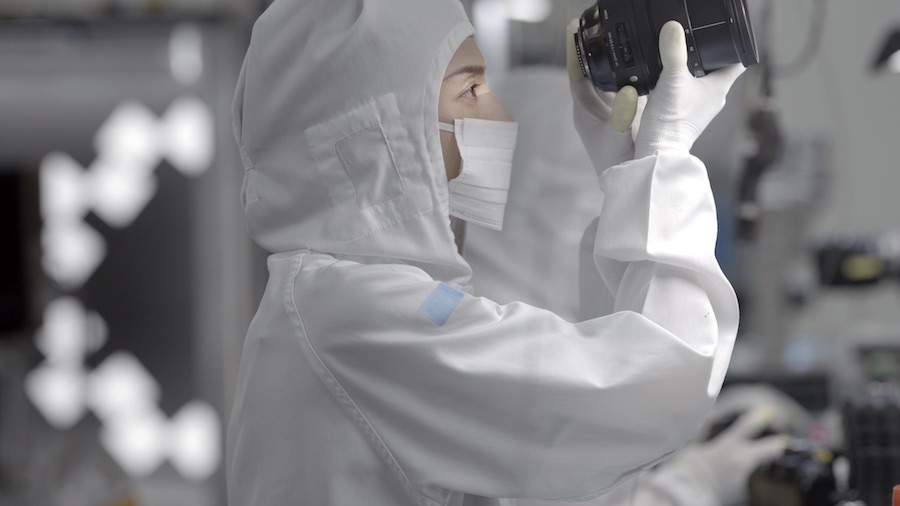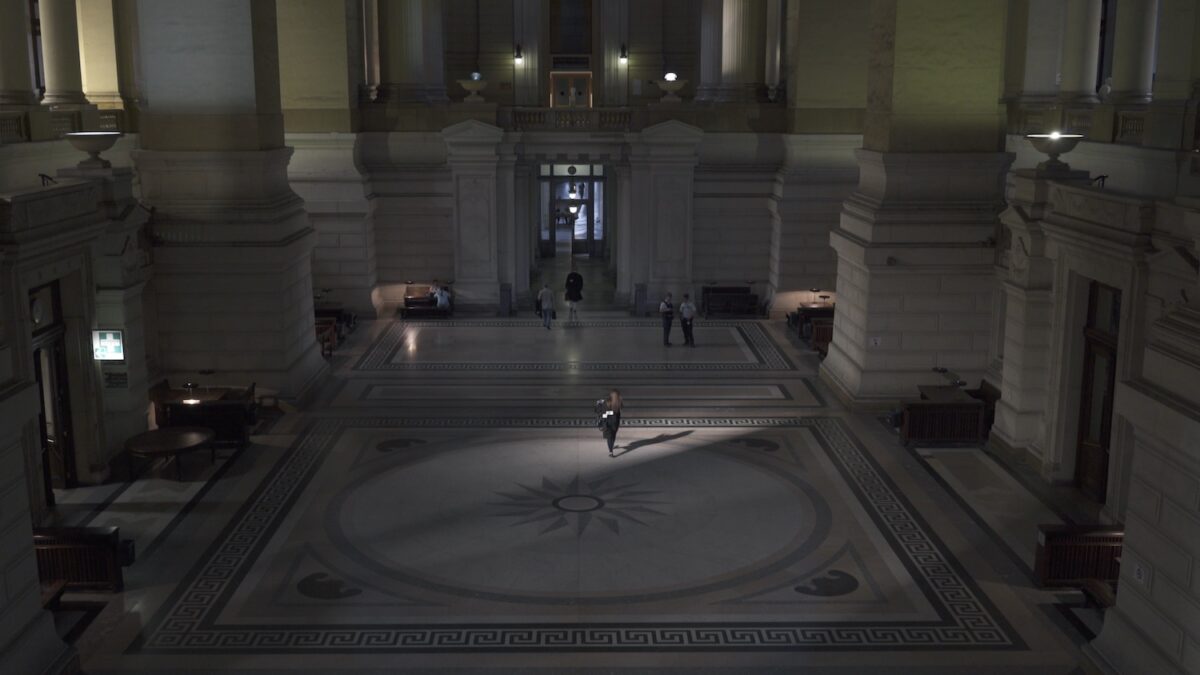Carey Young explores systems of power and gender equality in her solo show at Modern Art Oxford. ‘Palais de Justice’, 2017, is a surreptitiously-filmed view of the operation of courts in Brussels, edited to give the impression that the legal system is run by women. ‘The Vision Machine’, 2020, applies a parallel thought experiment by concentrating on the female workers only in a Japanese lens-manufacturing factory. And ‘Appearance’, 2023, is a silent ‘filmic portrait’ featuring 15 female judges. All three films, says Young, try to reverse ‘the male gaze’ by playing with some idea of a female gaze. And all three act as ‘thought experiments’: speculative fictions which turn documentary footage into the imagined future of a female world.

Carey Young: still from Appearance, 2023. © Carey Young. Courtesy of the artist and Paula Cooper Gallery, New York
What themes are you tackling in the show?
There are two main themes. The first is around my engagement – for over twenty years now – with law. The show includes many new pieces and traces a line through my law-based work … I’m interested in law as artistic medium and as a form of power in society. What is law? What are its aesthetics? Who gets to administer it? What are law’s performances, rituals, languages, materiality and what is its effect on us? These are questions which fascinate me, and I keep going back to them.
The other theme, equally pressing to me but more recently as a particular interest, is in women, and especially women’s relationship to cameras and to the regimes of cinema and photography, including in the social media era. I’m thinking about power in that sense, too.
Those themes relate to each other in different ways throughout the show. I wanted to create a triangular relationship between the overlapping themes of ‘Palais de Justice’, ‘The Vision Machine’, and ‘Appearance’. Then I added photographic and text works in the central space, which push the themes in other related directions. I wanted those works to have a sense of realism. They relate to contracts, prisons, land, Brexit – things we can recognise as being about law and the body, borders, transitions, something being at stake.
What proportion of court judges in Britain are women?
I only have figures for England and Wales, as that is one jurisdiction, and Scotland is another. At the moment, 35% are female, which is 10% more than a decade ago. In proportional terms, most women judges work in the lower courts, and only one on the highest court, the UK Supreme Court, so that is another imbalance. There also needs to be much more done to recruit more ethnically diverse judges, who account for 4% of court judges (and 9% if we also count male judges), as of 2022 figures, but are 18% of the UK population. And only 1% of judges are from black backgrounds – a figure that has not changed since 2014 (although some of the UK’s most senior non-white judges feature in Appearance). Efforts are being made to diversify the judiciary further but it is a slow process.
Appearance features judges who are diverse in age, seniority and ethnicity. I wanted to defy the stereotype – which is backed up by ongoing statistics – that judges are older white men. Here, the judges are a wide mix of women, from the youngest ever female judge (even six years on, she is only 37), to judges of various non-white ethnicities, to the UK’s only trans female judge, or the only female judge on the UK’s Supreme Court. Many went to state school. They are all trailblazers in one way or another, showing a future of the judiciary that better represents the UK population.

Carey Young: still from Appearance, 2023. © Carey Young. Courtesy the artist and Paula Cooper Gallery, New York
What guidance did you give the judges in ‘Appearance’?
They appear as they wish: all are wearing their real robes and their choice of shoes and jewellery; they could choose their make-up and how their hair was done. They could act as they wanted to on camera, although I did ask them to sit in a judge’s chair placed in the centre of the film studio, and if they were going to look at the camera, they should make eye contact with it. It wasn’t at all like acting – they could have any expression on their face, as they wished – they were conveying their own feelings. This resulted in a wide variety of expressions, from cool toughness to warmth, benevolence or self-consciousness. They remain enigmatic, though because they don’t speak. Most said the experience reminded them of being in court because they were surrounded by crew all facing them with rapt attention, which led to several of them replaying trials in their heads, which is visually very interesting on camera because the judges change expression throughout their takes. One of them – a very senior judge – decided to bow to the camera as she entered and exited the shot because she would bow to the court. It’s very surprising because she wears a gold-encrusted robe and is clearly very powerful, but those bows reverse that power, just for a moment.
But you did ask them not to wear wigs?
I wanted the work to be international, and judges outside the UK and Commonwealth don’t wear wigs. Also, I think the wigs look anachronistic. The judges defend them as a disguise: because they are vulnerable to possible retribution when they leave court, they cherish the anonymity provided by wig and robe. The piece hovers between this idea of the official identity of the judge and their personal aspects of self-expression – their subjectivity – which you see through close-ups: shoes, eyes, hair, earrings, glasses, even bat-shaped cufflinks. This conveys their individuality and humanity, as well as differences between them. The judges were happy with the idea that Appearance is about them as people as well as in their roles. I hope viewers will have the strange experience of feeling, as I did, slightly guilty watching the footage, as if they are facing each judge in court. That’s why I made it a single-screen work. By giving such a direct, frontal encounter with the judiciary, the work effectively puts the viewer ‘in the dock’. Along with Velasquez’ Pope Innocent X, Warhol’s ‘Screen Tests’ were an initial inspiration. It was an added extra – though I only found out later – that Warhol was originally inspired by the ‘Most Wanted’ ads of the New York Police Dept.

Carey Young: still from Appearance, 2023. © Carey Young. Courtesy of the artist and Paula Cooper Gallery, New York
The title suggests that appearance matters?
Judges rely on their robes to help them seem an anonymous and objective manifestation of ‘the law’. The title also relates to the idea – which persists, in which we’re indoctrinated – of judging women on their appearance. And it also refers to appearing – being formally summoned in person – at court. The appearance of law fascinates me for what it says about what law is. How a courtroom looks, sounds or even smells is very evocative. Such sensory experiences are often what we’ll remember most about a place. The aesthetics of law go far beyond black type on white paper. The more we examine this, the more we can understand the aesthetic vocabulary of how the state manifests its power.
How does the law need to improve?
The law claims to be neutral, but it really isn’t, especially in how it’s applied and in terms of who has power in it currently. In terms of the tenets the law holds dear, the scales of justice are balanced, justice is blind, and we’re all supposedly equal under the law – but we know that isn’t the case. Most people can’t afford legal representation; women are not believed by police or when they testify in court; racial bias abounds in policing and the legal system; and most judges are privileged older white men who don’t understand many societal issues. So, the quality of judging will be open to question until this is fully addressed. And legal language is so abstruse people can’t understand it without a lawyer, who of course, is unaffordable… So, part of my interest in law is a political one, of helping people to engage with and understand it as a system and a phenomenon and to emphasise that it belongs to us. We could change it. And we need to understand its power – it remains one of the few options to rein in corporate power.
What do the judges make of ‘Appearance’?
They trusted me and were happy not to see the footage before the work was exhibited. Some came to the exhibition opening. So far, they’ve been thrilled by all the sections that aren’t about them – and steel themselves for seeing themselves on screen, like most of us would. I’m looking forward to more discussions with them, such as at the public symposium at Modern Art Oxford on May 19th, at which a panel of participating judges will discuss the work with me.

Carey Young: still from The Vision Machine, 2020. © Carey Young. Courtesy of the artist and Paula Cooper Gallery, New York
Your speculative fiction in ‘The Vision Machine’ is that women are running the factory. How close is that to the true position?
There were a lot of male workers at the factory. I don’t think women have power positions in Japanese factories. SIGMA is a global corporation, but in essence, it is a family firm run by a man who inherited it from his father. But I don’t think that matters: I’m using the factory as a metaphor to talk about visual culture. What if women made tools that propagated an idea of female-centric visuality? What might that be?
So what the women are making is critical?
Yes… they are making lenses for photographic or cinema cameras, and I shot the piece with lenses made by those workers, so it’s a self-reflexive work about the act of making films. We also see the women testing lenses, so it’s about the means of production – in a Marxist sense – to make tools for vision. It’s also about paying respect to women as artists and as artisans: beyond the fact that women artists have long been sidelined or written out of art histories, the artistry and technical skill of women is another thing that’s completely side-lined. And that extends to how cameras and lenses are sold – the number of times I’ve been in a camera shop and the sales assistants have assumed that I must be an amateur because I’m a woman! That did help me when I was making ‘Palais de Justice’, though: I wasn’t authorised to shoot the footage, but I tended to get away with it because nobody thought I was a serious filmmaker – or even a filmmaker at all. They took me to be an assistant for someone else – presumably a male director. Being female was a kind of disguise.
Is there anything about you that people tend to find surprising?
I’m from that original house music generation and never stopped being into it, especially deep house and mellow techno. I don’t actually listen to anything else, and buy a lot of tracks online. In another life, I would have been a DJ.
Top Photo: Carey Young: still from Palais de Justice, 2017. © Carey Young. Courtesy of the artist and Paula Cooper Gallery, New York
Carey Young’s show ‘Appearance’ is at Modern Art Oxford to 2 July. You can, incidentally, read my review for Photomonitor of Young’s 2019 screening of ‘Palais de Justice’ at the Towner Gallery here.
Read More

